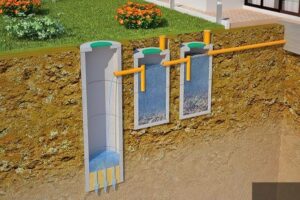
In plumbing, a cesspool is a type of system to treat wastewater that is underground. It’s like a big hole or tank that collects sewage and other liquid waste. Cesspools are built with strong materials like brick or concrete and are hidden underground.
Cesspools work by breaking down the waste through a process called anaerobic digestion. Solid waste settles at the bottom while the liquid waste breaks down with the help of bacteria. Gases like methane and carbon dioxide are created in the process, and the liquid waste eventually filters out into the soil, where it’s naturally purified. However, cesspools are not good for the environment because they can contaminate groundwater and nearby water bodies, and may be a health hazard.
Many places have banned cesspools and now encourage the use of more advanced wastewater treatment systems like septic tanks or connecting to the municipal sewer system.

Aerobic digestion is when oxygen and tiny living things break down organic material. This is often done in wastewater treatment plants to get rid of things like poo and food waste. This happens after bigger things have been removed. The little living things eat away at the remaining waste until it turns into smaller pieces that are more stable. This happens a lot like when things rot outside in the open air.
Doing this helps reduce the amount of waste and stops bad smells. It also makes something called biosolids which can be used like plant food. To keep the little living things alive, there needs to be oxygen around them all the time. This can be caused by machines pushing air around or some other things.

Pit latrines are widely used in many parts of the world, but they can cause environmental problems if they are not properly built, managed, or maintained.
Contamination of groundwater: If the pit latrine is not properly sealed or the soil around it does not filter well, contaminants can seep into the groundwater. This can pollute drinking water and spread diseases.
Surface water pollution: Poorly designed pit latrines can discharge untreated wastewater into nearby rivers, lakes, or streams, polluting these bodies of water and affecting the ecosystem and the health of humans and animals.
Soil pollution: Poorly built pit latrines can contaminate the surrounding soil, affecting soil quality, fertility, and the ability of plants to grow. It can also contaminate food crops if the contaminated soil is used for farming.
Odor and nuisance: If pit latrines are not properly managed, they can emit foul odors and attract disease-carrying vectors, contributing to a lower quality of life in the area.
Public health risks: If pit latrines are not properly emptied or maintained, there is an increased risk of disease transmission, leading to diseases such as cholera, typhoid, diarrhea or parasitic infections.
To reduce these risks, it’s important to build, maintain, and dispose of pit latrines safely, and to consider more advanced sanitation systems such as septic tanks.
Pit latrines are widely used in many parts of the world, but they can cause environmental problems if they are not properly built, managed, or maintained.

It’s important to remember that cesspools are not perfect and can’t be made completely environmentally friendly. If you can, other options might be better. Talk to local experts to find out what might work best for you.

A cesspool is an underground storage tank or pit designed to collect and store human waste and sewage. It is a traditional method of wastewater disposal that has been largely replaced by more efficient and environmentally friendly sewage treatment systems. However, some older properties may still have cesspools.
It’s important to note that cesspools are not considered an environmentally friendly or efficient method of wastewater disposal. They can contribute to water pollution, foul odors, and pose health risks if not maintained properly. Many jurisdictions now require the phasing out of cesspools in favor of more modern and sustainable sewage treatment systems.

Operating a cesspool properly is essential to prevent environmental contamination, foul odors, and potential health hazards.
As an environmentally friendly alternative, consider upgrading to a modern wastewater treatment system, such as a septic system or connecting to a public sewer system..
| M | T | W | T | F | S | S |
|---|---|---|---|---|---|---|
| 1 | 2 | 3 | 4 | 5 | 6 | |
| 7 | 8 | 9 | 10 | 11 | 12 | 13 |
| 14 | 15 | 16 | 17 | 18 | 19 | 20 |
| 21 | 22 | 23 | 24 | 25 | 26 | 27 |
| 28 | 29 | 30 | ||||

